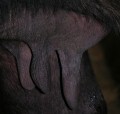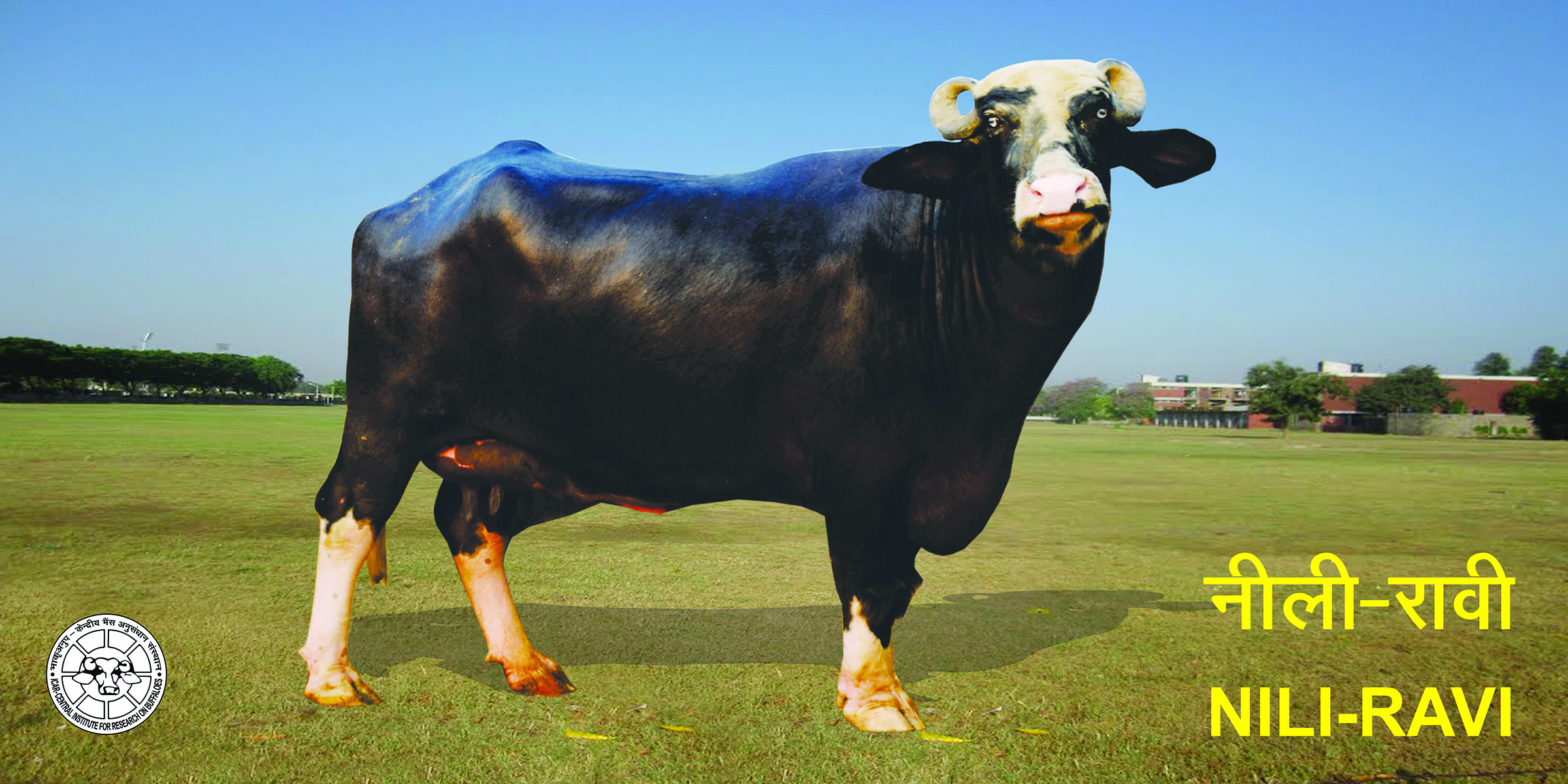Nili Ravi
- Origin & Breeding Tract
- Population
- Physical Characteristics
- Biometry
- Production Traits
- Reproduction Traits
- Housing Management & Practices
The home tract of Nili-Ravi buffaloes range in the belt between the Sutluj and Ravi rivers of the undivided Punjab Province. Actually Nili & Ravi were two different breeds long before, but due to the passage of time and with intensive crossbreeding, the two breeds converted into single breed named Nili-Ravi. Nili-Ravi buffaloes are found in almost all the districts, with major concentration in Amritsar, Gurdaspur and Ferozepur districts of Indian Punjab and in Lahore, Sheikhupura, Faizabad, Okora, Sahiwal, Multan, Bohawalpur and Bahwalnagar districts of Pakistan Punjab. However, due to good dairy characteristics of this breed in Pakistan, Nili-Ravi buffaloes are found in whole of Pakistan with major concentration in buffalo colony at Karachi, where large number of Nili Ravi buffaloes are procured from the breeding tract for supply of fresh milk to city residents.

 source: AK Jain and ML Mehra(Department of Animal Genetics & Breeding GADVASU ,Ludhiana)
source: AK Jain and ML Mehra(Department of Animal Genetics & Breeding GADVASU ,Ludhiana)
The estimated population of Nili-Ravi type of buffaloes in their breeding tract(Ferozepur, Amritsar and Gurudaspur districts of Punjab) is around 0.2 million(vij and Tantia,2005). The three districts have almost equal number of these animals. Ferozepur district, which is otherwise considered as a breeding tract of Nili-Rvi, now have more than 50% buffaloes of Murrah type. Ferozepur and Amritsar districts have only 10.8% and 8.7% of Nili-Ravi type buffaloes respectively. On the contrary, Gurudaspur district not known earlier as major breeding tract of Nili-Ravi, has the highest proportion 14% of Nili-Ravi type buffaloes. The majority of buffaloes in the breeding tract are now found to be non-descript with 72.6% in Amritsar, 68.7% in Gurudaspur and 36.1% in Ferozepur districts.
Buffaloes are major milk producer of the state of Punjab., India. A breed wise livestock census was first time conducted in Punjab in 2007 and population of different genetic groups of buffaloes is given in table.
| Breed / Group | Males | Females | Total | % age of total |
| Murrah | 0.93 | 8.70 | 9.63 | 19.25 |
| Nili-Ravi | 0.38 | 3.09 | 3.47 | 6.94 |
| Grade (non-descript) | 3.31 | 31.62 | 34.93 | 69.98 |
| Others | 0.21 | 1.78 | 1.99 | 3.98 |
| Total | 4.83 | 45.19 | 50.02 | — |
A perusal of the table reveals that Murrah is predominant buffalo breed (19.25% of total) in the state, while Nili-Ravi breed constitute only 6.94 % of the total buffalo population of Punjab. Graded buffaloes constitute 69.98% of buffalo herd of the state. As per the survey conducted by National Bureau of Animal genetic resources, karnal , most of the Nili-Ravi buffaloes found in Punjab are graded Nili-Ravi buffaloes and only very few are specimens of true breed. Most of the buffaloes having white marking on feet, forehead or walled in one or both eyes are considered Nili-Ravi breed but actually are grade Nili-Ravi buffaloes for which no separate class was envisaged in the livestock census of 2007.
Some of the important characteristics is described as follows: –
| Body color | The color is usually black but brown is not uncommon. |  |
| Horns | Horns are small, tightly curled but slightly less curled as compared to that of Murrah and circular in cross section. |  |
| Marking | White markings are found on hind legs, fore legs and white spots on forehead, muzzle. |  |
| Eye | They are usually walled eyes. |  |
| Tail | Tail is thick at the base, gradually tapers towards the end and extends below hocks with a white switch. |  |
| Body | Nili-Ravi buffaloes are large size and have deep and low set frames. | |
| Head | The head is elongated, bulging at top and is depressed between eyes. |  |
| Face | ||
| Neck | Neck is long and thin in females while it is thick and powerful in the male. |  |
| Ear | ||
| Limbs | ||
| Skin | ||
| Udder | Udder is well shaped,capacious and extends well forward upto naval flap. |  |
| Teats | Teats are long, even squarely placed. |
Body weight and Growth Rate
The mean values of body weight at birth, 6, 9,12,18,24 months and at first calving reported by various workers are presented below. The average daily gain in body weight was found to increase from birth to 6 months. However, it went on decreasing thereafter up to age at first calving (Sharma and Basu, 1984). In terms of body weight, on an average, Nili-Ravi animals gained 406.1g daily from birth to first calving.
| Stage | Sharma & Basu(1984) Mean +- S.E(Kg) | Singh(2003) Mean +- S.E(Kg) |
| At Birth | 29.27+-1.03 | 29.53+-0.10 |
| 3 months | 84.33+-3.10 | – |
| 6 months | 139.50+-4.84 | 144.07+-0.87 |
| 9 months | 185.86+-6.65 | – |
| 12 months | 243.25+-9.12 | 231.73+-1.52 |
| 18 months | – | 309.97+-1.76 |
| 24 months | 395.22+-15.85 | 380.66+-2.00 |
| At first calving | 531.06 | 516.30+-2.38 |
Morphological Characteristics
Various values of morphological traits of Nili-Ravi buffaloes like body length, height at withers, heart girth and adult weight reported by various workers are given in the following table.
| characteristics | Sex | ICAR(1941b) | Sarwar & Ishaq | Nivsarkar et al.(200) | Taneja(2004) | |||
| Nili | Ravi | Nili | Ravi | Nili-Ravi | Nili-Ravi | |||
| Body Length(cm) | Male Female | 159.0 149.0 | 155.0 150.0 | 157.5 147.3 | 154.9 149.8 | 160.0 165.4 | – – | |
| Height at withers(c) | Male Female | 137.0 136.0 | 133.0 127.0 | 132.2 127.0 | 132.1 127.0 | 140.0 134.2 | 140.0 134.0 | |
| Hearth Girth(cm) | Male Female | 226.0 225.0 | 224.0 215.0 | – – | – – | 230.0 207.7 | – – | |
| Birth Weight(Kg) | Male Female | – – | – – | – – | – – | 35.01 34.5 | 37.0 34.0 | |
| Adult weight(Kg) | Male Female | 600.0 450.0 | – – | – – | – – | 567.0 454.0 | 543.0 483.0 | |
| Traits | Weighted Average | Range in Different Reports |
| Average lactation length(days) | 306 | 262-319 |
| Average lactation milk yield (kg) | 1945 | 1688-2317 |
| Average daily milk yield (kg) | ||
| Peak milk yield (kg) | 9.4 | 7.2-11.8 |
| Average Fat% | 6.9 | 6.6-7.2 |
| Average SNF% |
. The average lactation yield was 1945 kg in Nili-Ravi buffaloes ranged between 1688 to 2317. Average fat of Nili-Ravi buffalo milk was 6.9% and was less in comparison to various reports on milk of Murrah buffaloes. source: AK Jain and ML Mehra(Department of Animal Genetics & Breeding GADVASU ,Ludhiana)
- Male
a) Age at puberty (months)
- Female
a) Age at puberty (months)
b) Age at First Calving (months)
|
AFC (days) |
No. of Observations |
References |
|
1556+- 18 |
– |
Amble et al. (1958) |
|
1248 +- 35.7 |
22 |
Amble et al. (1970) |
|
1224 |
27 |
Singh & Singh (1977) |
|
1259.72+-12.66 |
425 |
Reddy(1980) |
|
1137.48+- 34.37 |
– |
Singh et al. (1986) |
|
1282.75+- 10.14 |
423 |
Naqvi & Shami (1999) |
|
1387+- 22 |
89 |
Chawla et al. (2003) |
|
1427.10 |
– |
Munish Kumar(2004) |
c) Service Period(days)
The average first service period reported by various workers are presented in the following table. It varied from 138.37 to 280.96 days.
|
First Service Period |
No. of Observations |
References |
|
200.78 +- 10.32 |
340 |
Reddy (1980) |
|
221.53 +- 4.57 |
– |
Ahmad et al. (1983) |
|
280.96 +- 9.32 |
617 |
Naqvi & Shami (1999) |
|
202 |
– |
Nivsarkar et al. (2000) |
|
138.37 +- 9.00 |
78 |
Anonymous (2004) |
d) Dry Period (days)
The average first dry period reported by various workers is presented in the following table. It varied from 98.20 to 202.26
|
First Dry Period(days) |
No. of Observations |
References |
|
98.20 |
– |
Chaudhury and Shaw (1965) |
|
202.26 +- 8.00 |
386 |
Reddy (1980) |
|
126.50 +- 6.33 |
– |
Singh et al. (1986) |
|
306.39 +- 8.78 |
592 |
Naqvi & Shami (1999) |
|
151 |
– |
Nivsarkar (2000) |
|
136.29 +- 26.67 |
78 |
Anonymous(2004) |
e) Calving Interval (months)
The mean first calving interval reported by various workers is presented in the following table. It varied from 443.03 to 579.99 days.
|
First calving interval (days) |
No. Of observations |
References |
|
461.60 +- 18.76 |
20 |
Amble et al. (1958) |
|
444.90 +- 21.31 |
10 |
Amble et al. (1970) |
|
508.39 +- 10.10 |
368 |
Reddy (1980) |
|
520.50 +- 2.58 |
– |
Singh et al. (1986) |
|
490 |
– |
Nivsarkar et al. (2000) |
|
579.99 +- 12.90 |
– |
Taneja (2004) |
|
443.03 +- 49.31 |
78 |
Anonymous (2004) |
f) Estrous Cycle Length (days)
g) Estrous Duration(days)
h) Gestation Lengthn (days)

